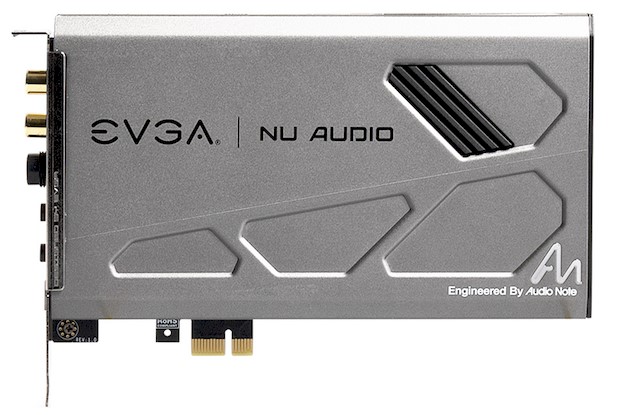EVGA NU Audio - A Sound Card For Gamers And Audiophiles
Take a look at the EVGA Nu Audio’s full list of features and specification below, and then we’ll dig in a little deeper and see what makes the card tick and how it performs with a variety of source material...
|
| Audio DSP | XMOS xCORE-200, Native DSD Support (up to x256) |
| Output Configuration | 2 Channel (Analog), 5.1 Channel (Digital via S/PDIF) |
| Dynamic Range (DNR) / Signal To Noise (SNR) | 123dB (Stereo Playback), 121dB (Line-In Recording) |
| Playback Format | Up to 384kHz, 32bit (Stereo), Up to 192kHz, 24bit (Optical) |
| Headphone Amp | 16-600 ohm (Independent Analog Control) |
| Maximum Voltage | 8Vrms |
| Maximum Current | 250mA |
| Recording Format | Up to 384kHz, 32bit (Line-In), Up to 192kHz, 24bit (Mic-In) |
| RGB Lighting | 10 - Mode w/ Audio Reactive Lighting |
| I/O | Stereo Out (RCA L/R), Headphone Out (6.3mm), Line-In (3.5mm), Mic-In (3.5mm), Optical Out (TOSLINK Passthrough), Front Panel Header |
| Premium Components | DAC - AKM AK4493, ADC - AKM AK5572, OP-AMP (Headphone) - ADI OP275, OP-AMP (Line Out) - ADI AD8056; Capacitors - WIMA, Audio Note(UK), Nichicon; Power Regulators - Texas Instruments TPS7A47/TPS7A33 ultralow-noise power solution |
| Switchable OP-AMPs | Headphone, Line out |
| Interface | PCIe x1 Gen2 |
| Power Connector | 1x SATA Power |
| Supported OS | Windows 10, 8.1, 7 |
There is a lot going under the hood of the EVGA NU Audio. At the card’s heart is an XMOS xCORE-200 DSP, which is used in some quality USB audio gear. In fact, the NU Audio is essentially a USB audio solution packed onto a PCB, The card's XMOS DSP is a USB controller that’s bridged to PCI Express via an ASMedia ASM1042. This may seem quizzical to some of you, but keep in mind that USB Audio Class 2.0 is a well-established standard for HiFi and Pro Audio production. The Dynamic Range (DNR) and Signal to Noise (SNR) are 123dB for stereo playback and 121dB for line-in recording, respectively, and the card supports a wide range of playback formats.
The EVGA NU Audio board itself is construction of a silver and gold-plated, multi-layer PCB, with isolated ground planes for the analog and digital circuits, to help cut down on noise transfer and interference. With all of the components and circuitry on the card, it does require additional power through a standard SATA connector (that feed is not just for lighting), but the circuitry is treated to its own copper shielding and is covered by a chunky heatsink.
All of the capacitors used on the card consist of high-quality Audio Note Standard, Nichicon solid, and Panasonic FC caps, and all of the other components were selected with an eye on quality as well. The Nu Audio card features an AKM AK4493 32-bit DAC with the aforementioned 123dB DNR, that feeds a balanced linear phase low-pass filter consisting of TI LME49724 fully-differential amplifiers. That signal is fed into an ADI AD8056 dual Op-Amp, which actually resides in a socket. Should users want to upgrade Op-Amps in the future, that is possible with the EVGA NU Audio as well.
The headphone output on the card has its own ADI OPA275 Op-Amp (also upgradeable, though not interchangeable with the AD8056 due to voltage differing voltage requirements), paired to dual TI LME49600 power amps. The headphone output feeds the 6.35mm headphone jack with a low impedance signal, to minimize noise and improve transient response. Also part of the headphone output is a Maxim DS1882, which allows for software-based volume controls.
Pumping audio into the card and converting analog signals to digital is handled by an AKM AK5572 32-bit ADC (121dB capable). The setup allows for studio-quality line-in recording at up to 384KHz. The microphone input has its own independent circuit as well, powered by the Cirrus Logic CS5346, which is a 24-bit 192KHz capable part with a max dynamic range of 103dB. The microphone circuit can be configured for line level signals as well, though it’s not as high quality as the dedicated line-in.
External I/O on the EVGA NU Audio card consists of gold-plated stereo line-outs, a 6.3mm headphone output, 3.5mm line and microphone inputs, and an S/PDIF output. Included with the card are a couple of adapters though; one 6.3mm to 3.5mm adapter and a dual RCA/component (male) to 3.5mm jack.










